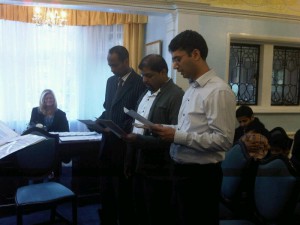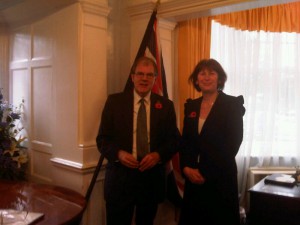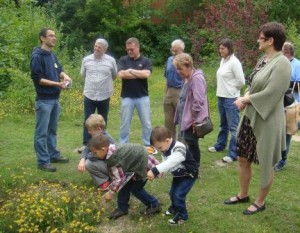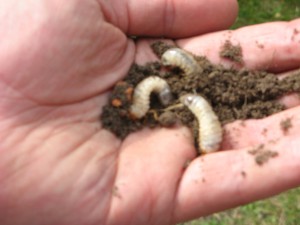On several occasions now, including 16 December, 10 November and 8 December 2011, Richard has been proud to represent the Borough (and the Government and the Queen) at a moving ceremony held in our Ward, at the Sutton Registry Office in Worcester Road, to confer British citizenship on new British citizens. These are people from all over the world who share a desire to be British citizens, and have taken examinations in the English language and in our history and way of life to obtain citizenship. On 16 December there were people from Iraq, Sri Lanka, India, Hong Kong and Rwanda. On 10 November there were people from Ethiopia, India, Nigeria,Pakistan, Sri Lanka, Bulgaria, Tunisia, South Africa and Zimbabwe, all of whom had successfully applied for British citizenship. On 8 December there were people from Nepal, Sri Lanka, India, the Ukraine, South Korea, the USA and the Congo.
Richard says “I find these ceremonies moving. Britain benefits enormously from being a multi-racial society, with so many different cultures learning from each other. These people will be a great credit to Britain, and are enthusiastic about becoming British citizens. They will bring to our country cultures and experiences that we will learn from and which will make Britain a better place.”

This is the text of his speech of welcome, elaborating on the standard speech normally made at this ceremony in order to draw particular attention to the many advantages of setting up home in the London Borough of Sutton, and the benefits to Sutton of the skills and experiences that people from such diverse backgrounds bring to our community.
“It is indeed a great pleasure for me to extend my personal welcome you all, as well as welcoming you on behalf of the London Borough of Sutton and on behalf of the government of Her Majesty Queen Elizabeth the second.
I am delighted that you have either chosen Sutton as a place to live or have chosen Sutton to celebrate this very special occasion.
Sutton cherishes its diversity and today we are celebrating this with all of you, people who come from many different parts of the world. You bring with you cultures and experiences which we will value, and which can help to continue to make Sutton a great place to live and to work. You have many opportunities to participate in the local community, in particular by volunteering to help in a wide range of groups and activities where your expertise and experience would be invaluable to the community.
Many of you have children. Sutton is proud to have excellent schools and opportunities for our young people. We look to inspire young people so they develop and thrive in a learning environment. This year students at Sutton schools achieved the best GCSE results in the country.
A recent study rated Sutton as the best place in London to bring up children. The study looked at factors such as low crime rates, affordability of houses, earnings and access to good schools, and concluded that Sutton is the best Borough in London to set up home. So, for those of you who have set up home in Sutton, congratulations on making such a wise choice.
Sutton is also the Borough with the highest percentage of residents in work – 78% of Sutton’s working age population has a job, and there is evidence that in this period of recession Sutton remains vibrant.
The green spaces and parks in Sutton enable everyone to enjoy their leisure time. Sutton is proud of its “green” environment – having over 1 500 acres of parks and open spaces and over 20 000 street trees. There is also a wide range of other facilities in the Borough such as libraries, theatres, and the Life centre, which encourages citizenship and learning.
Historically Sutton has been linked to the Queens and Kings of England. King Henry 8th was frequently a visitor to the Borough having a home in Nonsuch park.
This house that we are in today is a fine example of Victorian architecture, once inhabited by the Walls family, a name you may recognise, famous for their Walls Ice Cream and Walls Sausages. But there are many other heritage sites worthy of a visit including Whitehall in Cheam and The Honeywood centre in Carshalton. Since 1965 this building has been the Register office, registering important life events such as births, deaths marriages, civil partnerships and – today – people choosing to take British citizenship.
As we look across the world and realise how fortunate we are to live in a democracy, I urge you all as new citizens to use the opportunity to vote in our elections, to shape the future of the Borough and your new country. Your next opportunity to do that will be in May, when we elect a new Mayor of London and a London Assembly.
May I congratulate you all and wish you happiness and success as new British Citizens. “

This is Richard with the Registrar, who conducted the ceremony.





